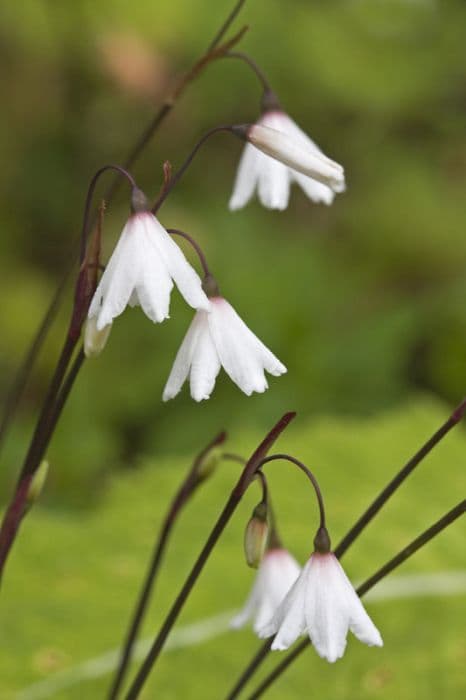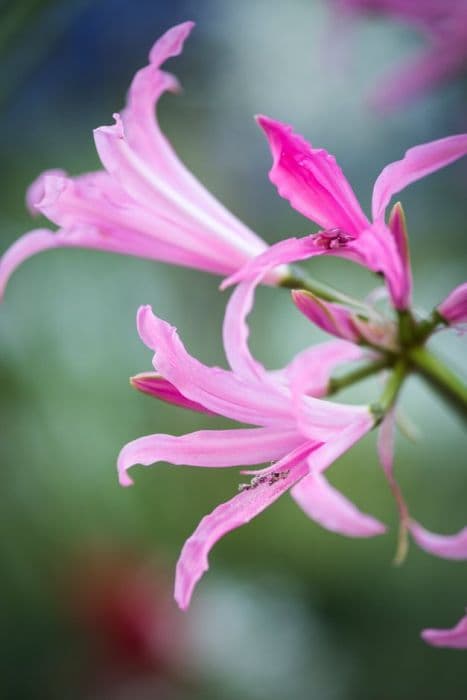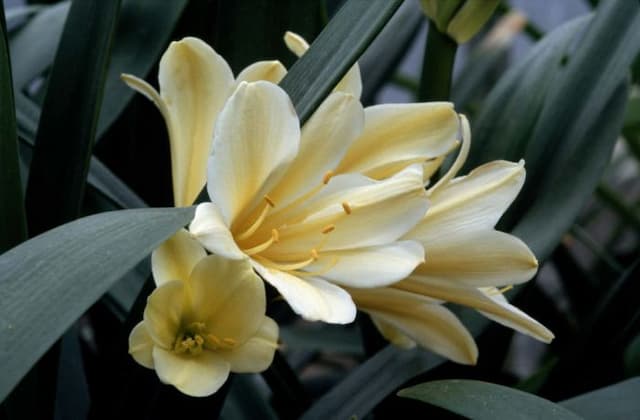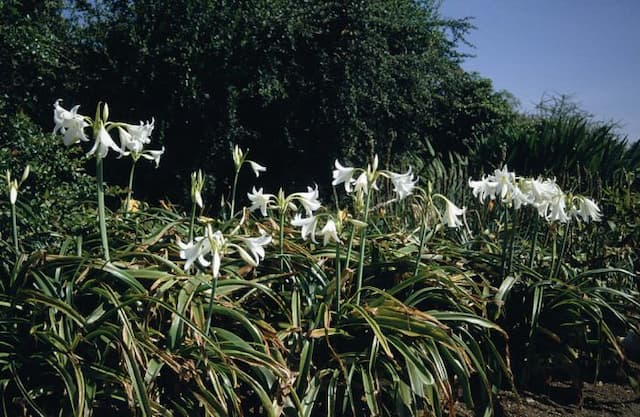Daffodil Narcissus 'Martinette' (8)

ABOUT
Narcissus 'Martinette' is a striking variety known for its vibrant display that signals the arrival of spring. The plant bears cheerful and showy flowers, which have an eye-catching arrangement and coloration. The blossoms consist of multiple flowers per stem, making it a bountiful display. Each flower has a vivid yellow bell-shaped cup in the center and is surrounded by a ring of six perky petals that exhibit a softer, often lemony yellow shade. This contrast creates a two-toned effect that is delightful to the eye. The petals are gently curved and may have a slightly ruffled edge, adding to their charm. The foliage of 'Martinette' is fresh and green, typically growing in long, narrow, strap-like leaves that arch gracefully away from the stem. These leaves complement the flowers by providing a lush background of green, which enhances the visual appeal of the golden blooms. As a herald of the warmer days to come, Narcissus 'Martinette' radiates joy and brightness in the garden. It is often planted in groups or clusters to maximize visual impact, and its flowers make excellent cut arrangements for indoor enjoyment. Additionally, the sweet fragrance of the blooms is a delightful bonus, contributing to the overall sensory appeal of this endearing plant.
About this plant
 Names
NamesFamily
Amaryllidaceae.
Synonyms
Daffodil, Jonquil.
Common names
Narcissus 'Martinette'.
 Toxicity
ToxicityTo humans
Daffodil, specifically the Narcissus 'Martinette', contains toxic alkaloids such as lycorine and is poisonous if ingested. The primary consequence of ingesting any part of the plant, especially the bulbs, can include symptoms such as nausea, vomiting, abdominal pain, and diarrhea. In severe cases, ingestion can lead to cardiac arrhythmias, low blood pressure, tremors, convulsions, and even life-threatening situations if large amounts are consumed.
To pets
Daffodil, which refers to the Narcissus 'Martinette' in this case, is toxic to pets if ingested. The plant contains harmful alkaloids, including lycorine. Symptoms of daffodil poisoning in pets may include vomiting, salivation, diarrhea, convulsions, low blood pressure, tremors, and cardiac arrhythmias. In severe cases, ingestion of the bulb, which is the most toxic part, could potentially be fatal to pets.
 Characteristics
CharacteristicsLife cycle
Perennials
Foliage type
Deciduous
Color of leaves
Green
Flower color
Yellow
Height
1-1.5 feet (30-45 cm)
Spread
0.5 feet (15 cm)
Plant type
Bulb
Hardiness zones
3-9
Native area
Europe
Benefits
 General Benefits
General Benefits- Attractive blooms: Narcissus 'Martinette' is known for its showy, fragrant flowers that add aesthetic appeal to gardens.
- Easy to grow: They are generally low-maintenance and can thrive with minimal care, making them suitable for novice gardeners.
- Perennial growth: As a perennial, they return year after year, providing long-term value for the garden.
- Spring color: Blooming in early spring, they bring vibrant color to the garden after the winter months.
- Naturalizing: These plants can spread over time, filling garden spaces and creating a natural, full look.
- Deer resistance: They are known to be resistant to deer, which can help preserve your garden in areas where deer are common.
- Attracts pollinators: The bright flowers attract bees and other pollinators, which are essential for the health of the garden ecosystem.
 Medical Properties
Medical Properties- This plant is not used for medical purposes.
 Air-purifying Qualities
Air-purifying QualitiesThis plant is not specifically known for air purifying qualities.
 Other Uses
Other Uses- Narcissus 'Martinette', commonly known as daffodil, can be used as a natural dye for fabrics, yielding various shades of yellow depending on the mordant used.
- Daffodil bulbs can be ground into a paste and used as a natural glue for paper or light materials.
- The daffodil's sturdy stems can serve as makeshift supports for other weaker-stemmed plants in a garden.
- Crushed daffodil petals can be added to potpourri mixtures for a unique, spring-like fragrance.
- Pressed daffodil flowers can be used in art projects, such as creating floral bookmarks or decorative cards.
- Daffodil plants can act as a pest deterrent in gardens, especially against rodents that dislike their toxic properties.
- Dried daffodil petals can be used in homemade soaps for exfoliation and natural colouring.
- The daffodil's distinctive trumpet-like shape can inspire designs in art, architecture, and jewelry.
- Daffodil cuttings can be composted to create a nutrient-rich soil conditioner for gardens.
- Larger daffodil bulbs can be hollowed out and used as molds for making small candles or soap bars.
Interesting Facts
 Feng Shui
Feng ShuiNarcissus, known in Chinese culture as the symbol of wealth and prosperity, can be used in Feng Shui to attract good fortune and rebirth. It is commonly placed in the home during the Chinese New Year and is believed to bring good luck when placed in the wealth corner, or southeast area, of a living space.
 Zodiac Sign Compitability
Zodiac Sign CompitabilityThe Narcissus is not used in astrology practice.
 Plant Symbolism
Plant Symbolism- Rebirth and New Beginnings: The Narcissus, widely recognized as a symbol of spring, is often associated with renewal and the emergence of new life because it is one of the first flowers to bloom as winter ends.
- Self-Reflection: Inspired by the Greek myth of Narcissus, this flower also represents self-reflection and introspection. In the tale, Narcissus is known for his beauty and his obsession with his reflection, leading to the flower being a symbol of vanity.
- Wealth and Prosperity: In some cultures, Narcissus is associated with wealth and good fortune. It's often celebrated during the Chinese New Year as a bringer of prosperity and success in the coming months.
- Hope: The Narcissus is emblematic of hope, as its early spring appearance serves as a cheerful reminder that brighter days are ahead after the dark, cold winter months.
 Water
WaterDaffodils, including the Narcissus 'Martinette', prefer to be watered deeply and infrequently. Water them when the top inch of soil feels dry, which may roughly translate to once a week depending on climate and soil conditions. During the growing season, they may need approximately one gallon of water per square foot every week. Once flowering has finished and the leaves begin to yellow, you can reduce watering as the plant goes dormant. Overwatering or waterlogged soil can lead to bulb rot, so ensure good drainage.
 Light
LightDaffodils thrive in full sun to partial shade. The ideal spot for daffodils is where they can receive at least six hours of direct sunlight each day. However, they can also tolerate some shade and may benefit from being planted under deciduous trees which provide filtered sunlight and protection from harsh afternoon sun.
 Temperature
TemperatureDaffodils are hardy and can withstand a wide range of temperature conditions. They typically survive winter temperatures as low as -20°F and can tolerate summer heat up to 90°F. The ideal temperature for active growth and flowering is between 50°F and 70°F.
 Pruning
PruningPruning daffodils is not required for plant health, but it helps maintain a tidy appearance. After flowering, you can deadhead spent blooms, but leave the foliage intact until it turns yellow and begins to wither. This allows the plant to gather energy for the next year's bloom. Typically, this cleanup occurs in late spring or early summer.
 Cleaning
CleaningAs needed
 Soil
SoilDaffodil 'Martinette' thrives best in well-draining, fertile soil with a pH of 6.0 to 7.0. An ideal soil mix would include equal parts loam, sand, and compost to ensure proper drainage and fertility. Slightly acidic to neutral soil conditions are optimal for the growth of daffodils.
 Repotting
RepottingDaffodils, including the 'Martinette', typically do not require frequent repotting. They should be repotted if the bulbs become overcrowded, usually every 3-4 years. It’s best to repot after the foliage has died back post-flowering.
 Humidity & Misting
Humidity & MistingDaffodil 'Martinette' is tolerant of a wide range of humidity levels and does not require any special humidity considerations. These flowers are adaptable to outdoor conditions where humidity varies naturally.
 Suitable locations
Suitable locationsIndoor
Place in bright, indirect light. Keep soil moist but not wet.
Outdoor
Plant bulbs in fall in well-draining soil. Full to partial sun.
Hardiness zone
3-9 USDA
 Life cycle
Life cycleThe Narcissus 'Martinette', commonly known as Daffodil 'Martinette', begins its life cycle with a dormant bulb, which is typically planted in the fall before the ground freezes. In early spring, shoots emerge from the bulb, developing into stems and leaves, with the iconic yellow-orange flowers blooming by mid-spring. After flowering, the plant enters a post-blooming phase where it stores energy in the bulb for the next season, during which the foliage should remain until it yellows and dies back naturally. The bulb then enters a summer dormancy period, where it remains underground in a state of rest. As cooler temperatures return in autumn, the bulb prepares for the next growth cycle. This annual cycle continues year after year, with the potential for the bulbs to divide and produce offsets, thus expanding the plant cluster over time.
 Propogation
PropogationPropogation time
Spring to early summer
The most popular method of propagating Narcissus 'Martinette', commonly known as daffodil, is through dividing and replanting its bulbs, which is typically done in late summer to fall, after the leaves have died back but well before the ground freezes. To propagate, one would carefully dig up the clump of daffodil bulbs, ensuring not to cut into the bulbs with the shovel. Once out of the ground, gently separate the bulbs by hand, taking care to keep as many roots intact as possible. Each bulb should have a portion of the base and some roots to be viable. After dividing, the bulbs should be immediately replanted at a depth of about 6 inches (approximately 15 centimeters) and spaced approximately 3 to 6 inches apart (about 7.5 to 15 centimeters) to allow for adequate growing room. Soil should be well-draining to prevent bulb rot. This division method helps to rejuvenate overcrowded beds, and encourages more vigorous blooming in the following spring.









